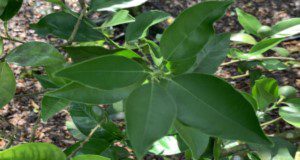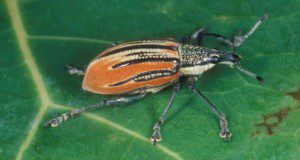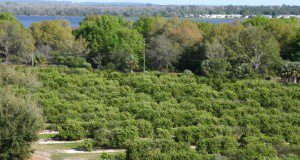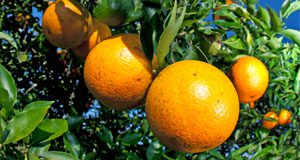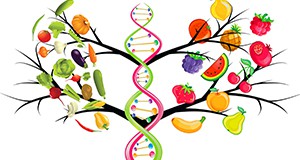To maintain balanced nutrients for optimal tree growth, citrus growers need to assess trees’ nutritional requirements. These assessments help prevent any nutrient deficiency or toxicity from compromising tree health and yield or reducing revenue. This new illustrated two-page instructional sheet gives a basic procedure for the citrus leaf sampling process, as well as additional suggestions for HLB-affected trees. Written by Tripti Vashisth, Jamie D. Burrow, Davie Kadyampakeni, and Rhuanito S. Ferrarezi, and published by the UF/IFAS Horticultural Sciences Department.
https://edis.ifas.ufl.edu/hs1355
Tag: Jamie Burrow
Children’s Citrus Activity: Diaprepes Root Weevil
This new two-page children’s activity sheet features pictures of Diaprepes root weevil larva and adults as well as feeding damage. Page two includes a maze. Written by Lauren M. Diepenbrock and Jamie D. Burrow and published by the UF/IFAS Extension 4-H Youth Development program.
http://edis.ifas.ufl.edu/4h403
Children’s Citrus Activity: Citrus Counting
Florida is well known for its citrus industry, valued at over eight billion dollars, and is one of the top citrus-producing states in the United States. This new one-page children’s activity sheet about Florida citrus includes an activity for students learning to count and match. Written by Jamie D. Burrow and Ariel Singerman and published by the UF/IFAS Extension 4-H Youth Development Program.
http://edis.ifas.ufl.edu/4h402
Citrus Disorders and Physical/Chemical Injuries
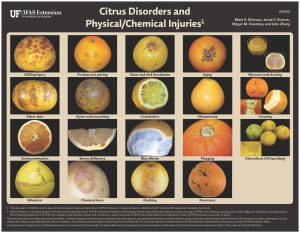
This new one-page Citrus Identification fact sheet illustrates different disorders and injuries that affect citrus. Written by Mark A. Ritenour, Jamie D. Burrow, Megan M. Dewdney, and John Zhang and published by the Horticultural Sciences Department.
http://edis.ifas.ufl.edu/hs1290
Huanglongbing (HLB; citrus greening) and Nutrient Deficiency Identification
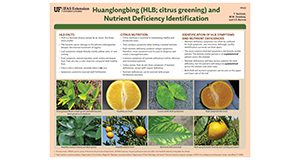
Huanglongbing (HLB) is a bacterial disease that is spread by an insect, the Asian citrus psyllid. This two-page fact sheet, which is best viewed as a PDF, http://edis.ifas.ufl.edu/pdffiles/PP/PP32800.pdf, explains how to tell the difference between HLB symptoms and symptoms from nutrient deficiencies. Written by T. Vashisth, M.M. Dewdney, and J.D. Burrow and published by the Plant Pathology Department.
http://edis.ifas.ufl.edu/pp328
Citrus Nutrition UF/IFAS Grower Trials (Pamphlet)
Interested in learning more about citrus nutrition grower trials? This two-page pamphlet provides information on the goals, objectives, benefits, and considerations of the trials as well as specific information about trials being held from 2015-2017. The pamphlet also contains a sign up form for the trials. Written by Tripti Vashisth and Jamie D. Burrow and published by the Horticultural Sciences Department.
http://edis.ifas.ufl.edu/hs1283
Huanglongbing (HLB; citrus greening) Leaf and Fruit Symptom Identification
Huanglongbing (HLB), commonly known as citrus greening, is a bacterial disease that affects all citrus varieties. This two-page fact sheet describes the leaf and fruit symptoms of HLB. Written by Jamie D. Burrow and Megan M. Dewdney and published by the Department of Plant Pathology.
http://edis.ifas.ufl.edu/pp327
Plant Diagnostic Clinic and HLB Lab
The Plant Pathology program at the UF/IFAS Southwest Research and Education Center is the state and local resource for plant diagnostic services, including HLB (Huanglongbing, or citrus greening) detection, and for insect identification. This brochure covers the center’s history, instructions for sending samples to the HLB lab, answers to frequently asked questions, and center hours and contact information. Written by Pamela Roberts, Shea Teems, Joubert Fayette, and Jamie Burrow, and published by the UF Department of Plant Pathology, July 2015.
http://edis.ifas.ufl.edu/pp319
Phytophthora Identification and Sampling in Citrus Nurseries
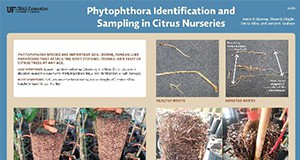
Phytophthora species are important soil-borne, fungus-like pathogens that attack the root systems, trunk, and fruit of citrus trees at any age. The front of this identification sheet includes images of healthy and infested roots and descriptions of leaf and root symptoms. The back lists sampling procedures: soil collection, soil testing, and diagnosing phytophthora. Written by Jamie D. Burrow, Diane B. Bright, Tim D. Riley, and James H. Graham, and published by the UF Department of Soil and Water Science, July 2015.
http://edis.ifas.ufl.edu/ss645
Postbloom Fruit Drop (PFD) Identification and Management
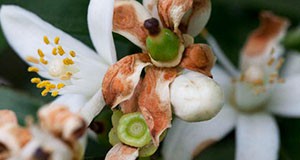
This two-sided ID card is idea for growers working in the field trying to identify or manage postbloom fruit drop (PFD) in citrus. The ID card includes photos of blooms affected by PFD and photos of healthy blooms for comparison. The card also includes facts and tips for managing PFD. Written by Megan M. Dewdney, Natalia A. Peres, and Jamie D. Burrow, and published by the UF Department of Plant Pathology, July 2015.
http://edis.ifas.ufl.edu/pp318
Sintomas de Cancro Citrico en Arboles de Vivero (PP307)
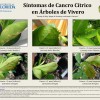 This is a two-page illustrated identification sheet for citrus canker symptoms that appear in citrus nurseries. Written by Timothy D. Riley, Megan M. Dewdney, and Jamie D. Burrow, and published by the UF Department of Plant Pathology, May 2013.
This is a two-page illustrated identification sheet for citrus canker symptoms that appear in citrus nurseries. Written by Timothy D. Riley, Megan M. Dewdney, and Jamie D. Burrow, and published by the UF Department of Plant Pathology, May 2013.
http://edis.ifas.ufl.edu/pp307
Citrus Canker Symptoms on Nursery Trees (PP304)
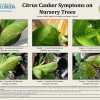 This document is a two-page illustrated identification sheet for citrus canker symptoms that appear in citrus nurseries. Written by Timothy D. Riley, Megan M. Dewdney, and Jamie D. Burrow, and published by the UF Department of Plant Pathology, April 2013.
This document is a two-page illustrated identification sheet for citrus canker symptoms that appear in citrus nurseries. Written by Timothy D. Riley, Megan M. Dewdney, and Jamie D. Burrow, and published by the UF Department of Plant Pathology, April 2013.
http://edis.ifas.ufl.edu/pp304
Quick Sheet: Insecticides and Miticides Recommended for Use in the Florida Citrus Pest Management Guide (ENY854/IN807)
 This document is a two-page quick reference guide to citrus insecticides and miticides recommended in the Florida Citrus Pest Management Guide, their effects on important citrus pests, and their natural enemies. Written by M.E. Rogers, P.A. Stansly, L.L. Stelinski, and J.D. Yates, and published by the UF Department of Entomology and Nematology, January 2012.
This document is a two-page quick reference guide to citrus insecticides and miticides recommended in the Florida Citrus Pest Management Guide, their effects on important citrus pests, and their natural enemies. Written by M.E. Rogers, P.A. Stansly, L.L. Stelinski, and J.D. Yates, and published by the UF Department of Entomology and Nematology, January 2012.
http://edis.ifas.ufl.edu/in807
Identificacion de los sintomas del cancro citrico y procedimientos de descontaminacion (PP214SP/PP138)
 El cancro cítrico es una seria enfermedad de los cítricos. La mayoría de los cultivos de cítricos son susceptibles, la toronja, la lima mejicana y algunas naranjas tempranas son las más susceptibles. Una infección severa puede causar defoliación, una muerte regresiva de la rama, una decadencia general del árbol, una caída prematura de la fruta, y manchas en la misma. Los árboles severamente infectados se vuelven débiles, improductivos y no rentables. This 5-page fact sheet was written by Mongi Zekri, Megan Dewdney, Jamie Burrow, and Pamela Roberts, and published by the UF Department of Plant Pathology, August 2012.
El cancro cítrico es una seria enfermedad de los cítricos. La mayoría de los cultivos de cítricos son susceptibles, la toronja, la lima mejicana y algunas naranjas tempranas son las más susceptibles. Una infección severa puede causar defoliación, una muerte regresiva de la rama, una decadencia general del árbol, una caída prematura de la fruta, y manchas en la misma. Los árboles severamente infectados se vuelven débiles, improductivos y no rentables. This 5-page fact sheet was written by Mongi Zekri, Megan Dewdney, Jamie Burrow, and Pamela Roberts, and published by the UF Department of Plant Pathology, August 2012.
http://edis.ifas.ufl.edu/pp138
Enfermedades Exoticos de los Citricos (PP296)
 Este documento es una hoja de dos páginas ilustrativas para la identificación de las enfermedades exóticas de los cítricos. This 2-page fact sheet was written by M. M. Dewdney, J. D. Burrow, M.E. Rogers, and T. M. Spann, and published by the UF Department of Plant Pathology, August 2012.
Este documento es una hoja de dos páginas ilustrativas para la identificación de las enfermedades exóticas de los cítricos. This 2-page fact sheet was written by M. M. Dewdney, J. D. Burrow, M.E. Rogers, and T. M. Spann, and published by the UF Department of Plant Pathology, August 2012.
http://edis.ifas.ufl.edu/pp296
Enfermedades fungicas foliares de los citricos para los patios y zonas residenciales (PP297)
 Este documento es una hoja de dos páginas ilustrativas para la identificación de las enfermedades fúngicas foliares de los cítricos. This 2-page fact sheet was written by M. M. Dewdney and J. D. Burrow, and published by the UF Department of Plant Pathology, August 2012.
Este documento es una hoja de dos páginas ilustrativas para la identificación de las enfermedades fúngicas foliares de los cítricos. This 2-page fact sheet was written by M. M. Dewdney and J. D. Burrow, and published by the UF Department of Plant Pathology, August 2012.
http://edis.ifas.ufl.edu/pp297
A Web-Based Tool for Timing Copper Applications in Florida Citrus (PP289)
 The Citrus Copper Application Scheduler provides citrus growers with an easy-to-use tool to guide copper application decisions. It is an updated version of a previous copper residue model This 4-page fact sheet was written by Megan M. Dewdney, Clyde W. Fraisse, Tiago Zortea, and Jamie Burrow, and published by the UF Department of Plant Pathology, January 2012.
The Citrus Copper Application Scheduler provides citrus growers with an easy-to-use tool to guide copper application decisions. It is an updated version of a previous copper residue model This 4-page fact sheet was written by Megan M. Dewdney, Clyde W. Fraisse, Tiago Zortea, and Jamie Burrow, and published by the UF Department of Plant Pathology, January 2012.
http://edis.ifas.ufl.edu/pp289
